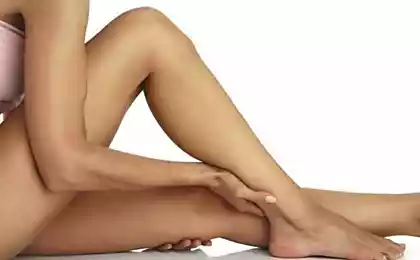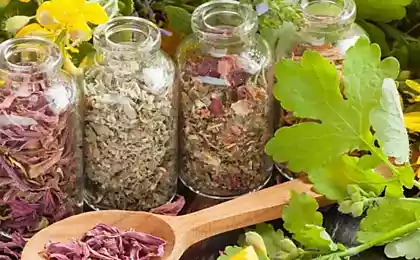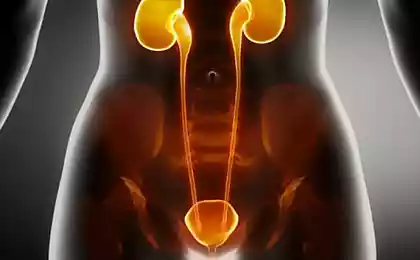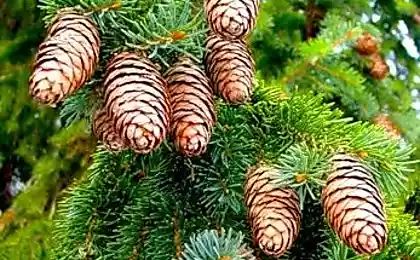479
The healing properties of horsetail
Horsetail is a perennial spore herbaceous plant of the family howevah. Horsetail rhizome long, creeping, deepening into soil to 1,5 m. the Stalks, appearing in early spring, not branchy, thick, juicy, height 7-15 sm, on a top carry spore-bearing spikelets in an oval head. After the spores Mature the stems die off and later develop barren branched, green, jointed stems 15-50 cm

It is necessary to distinguish not medicinal kinds of a horsetail: a horsetail, which has arcuate branches hanging down and re-branched; meadow horsetail, growing in meadows and fields, on top of its stem is visible wrinkled dark residue spore-bearing spikelets; horsetail fen with thick stems up to 1 m; marsh horsetail with devushkina branches (very similar to a horsetail, but differs in the hollow branches and the presence of spore-bearing spikelets at the top).
Common horsetail field everywhere in Russia, except desert of Central Asia.
Grows on sandy meadows, inundated woods, among thickets and bushes, on steam fields, on slopes of ravines and river banks, forest edges and along forest hog.
Used summer green vegetative shoots of Equisetum collected during June, July, August. The smell of the dried plant is missing, the taste slightly sour.
Chemical composition
Horsetail grass contains little-studied equisetonin saponin (about 5%), alkaloids (equiseti), flavonoids, ascorbic acid, carotene, malic, Aconitum, oxalic, silicic acid, calcium, bitter, tannin, resinous substances, proteins, carbohydrates, fatty oil.
As it turned out, the horsetail in a large number of extracts from the soil silicic acid and depositing it in its cell membranes. As well as some of its salts are soluble in water and silicic acid itself is an essential part of the human body (especially connective tissue, skin, hair and nails), people learned to improve their condition using drugs from horsetail.
Horsetail isolated from 5-glycosides-luteolin stops the inflammatory processes. Thanks to him, the plant successfully heals wounds and has a styptic (an internal and external bleeding), antiseptic and disinfectant action. Flavonoids along with saponins act as a diuretic.
Eguisetophyta bath
But it is best to use a horsetail bath. They stimulate metabolism in the skin and are good for poor circulation and also affect swelling, fractures, frostbite, abscesses, and suppuration of bones (open fractures). Eguisetophyta baths also facilitate the state in the majority of rheumatic diseases and the metabolic disorders gout, as soluble silicic acid when bathing partially enters the skin.
Treatment hosam field
This medicinal plant does not need advice — its benefit at very many diseases, even such serious as atherosclerosis vessels of the heart and brain or tumors in the stomach and intestines.
Horsetail has a bracing and cardiotonic action. In folk and scientific medicine he is best known as a diuretic and anti-inflammatory agent in diseases of the kidneys and bladder. Decoction and infusion of horsetail grass, not worse kidney tea removes from the body excess liquid, without affecting its salt composition, improves the overall metabolism in the body, reduces edema of different origin (for bruises, fractures, frostbite), especially well removes puffiness of the heart.
Horsetail extract increases filtration in the renal glomeruli and prevents the formation of stones and improves the elasticity of the connective tissues, activates metabolic processes in hair and nails. In addition, it has been experimentally proven that horsetail extract promotes excretion of excess cholesterol, toxins (particularly lead).
And horsetail can be used for foot baths with sweating feet and to combat seborrhea, as well as in the treatment of wounds, fistulas and ulcers on the skin.
Harvesting herbs
For medicinal purposes the herb should be harvested from June to August. Collect summer green stems and quickly dried in the shade, in well ventilated spaces: in attics, under a canopy, spreading a thin layer. Do not play wet horsetail thick layer, as in slow drying, it quickly darkens and loses its healing qualities! Keep it in a dry ventilated area. The dried stems are 20-30 cm long, stiff, branched, grayish-green, mild odor, sour taste. They should be stored in canvas bags or in paper bags. Shelf life up to four years.
Folk remedies from a horsetail
Infusion for ingestion
Boil 20 g of horsetail grass, 200 ml of boiling water, insist 1 hour, strain. Take 1-2 tablespoons 3-4 times a day with urolithiasis, edema of cardiac origin, inflammatory diseases of the bladder, liver, female diseases, atherosclerosis, and hypertension. This infusion can wash long unhealed, festering wounds, ulcers, bedsores, wipe the face with a porous skin, make bathing for eczema, boils, compresses to painful joints for gout, rheumatism, pleurisy. It is possible to rinse the mouth and throat with angina and other inflammatory processes.
The broth
Boil 25 g of horsetail 200 ml of boiling water, boil for 30 minutes on low heat, strain. By reducing the volume of liquid add boiling water. Take 1 tbsp 3-4 times a day after meals as a diuretic for edema renal and cardiac origin, exsudative by pleurisy, inflammatory diseases of the kidney, bladder. A decoction of horsetail, you can also rinse the mouth and throat, wash wounds, ulcers, bed sores areas of skin affected by eczema, furunculosis, to make compresses on the sore joints.
Juice
Rinse and chop fresh herbs of horsetail, wring out the juice. Store in a cool place. Take 2 tsp 3-4 times a day as a diuretic for edema. Wash bleeding, suppurating wounds, ulcers. You can drip into the nose, 2-3 drops of frequent nasal bleeding.
In scientific medicine preparations of horsetail are used mainly as a diuretic and anti-inflammatory. They are often recommended to the elderly for the treatment of edema of various origins, some heart diseases, kidney, urinary bladder, kidney stones, atherosclerosis of vessels of heart and brain, tuberculosis, and to remove lead from the body.
In folk medicine, extracts from horsetail is also used to treat hypertension, diabetes, prostatitis, rheumatism, hepatitis, stomach ulcers; Externally (lotions, baths, compresses, rinses) treat a sore throat, eczema, wounds, bruises, burns, conjunctivitis. Wash your hair with dandruff and poor hair growth legs-when they are excessive sweating. (Horsetail can wash dishes).
More recipes
Broth. Pour 1 tbsp. spoon of dry grass 200 ml of boiling water, boil 30 minutes, cool 10 minutes, take 2-3 tablespoons 3-4 times a day an hour after eating.
The infusion. Drink 1 tablespoon of herb to 200 ml of cold water for 24 hours. Take 2 tablespoons 1 hour after meals. Do and differently. Pour 2 tablespoons of herb to 200 ml of boiled water, 15-20 minutes, taking small doses in the form of heat during the day.
Juice. Chopped herbs mixed 1:2 with cold water, insist 1 hour, press through cheesecloth and used externally.
Preparations of horsetail are not recommended to take inside with acute nephritis — it can cause irritation of the kidneys. published
P. S. And remember, only by changing their consumption — together we change the world! ©
Source: vk.com/slavkrasa_ru?w=wall-65606366_2656%2Fall

It is necessary to distinguish not medicinal kinds of a horsetail: a horsetail, which has arcuate branches hanging down and re-branched; meadow horsetail, growing in meadows and fields, on top of its stem is visible wrinkled dark residue spore-bearing spikelets; horsetail fen with thick stems up to 1 m; marsh horsetail with devushkina branches (very similar to a horsetail, but differs in the hollow branches and the presence of spore-bearing spikelets at the top).
Common horsetail field everywhere in Russia, except desert of Central Asia.
Grows on sandy meadows, inundated woods, among thickets and bushes, on steam fields, on slopes of ravines and river banks, forest edges and along forest hog.
Used summer green vegetative shoots of Equisetum collected during June, July, August. The smell of the dried plant is missing, the taste slightly sour.
Chemical composition
Horsetail grass contains little-studied equisetonin saponin (about 5%), alkaloids (equiseti), flavonoids, ascorbic acid, carotene, malic, Aconitum, oxalic, silicic acid, calcium, bitter, tannin, resinous substances, proteins, carbohydrates, fatty oil.
As it turned out, the horsetail in a large number of extracts from the soil silicic acid and depositing it in its cell membranes. As well as some of its salts are soluble in water and silicic acid itself is an essential part of the human body (especially connective tissue, skin, hair and nails), people learned to improve their condition using drugs from horsetail.
Horsetail isolated from 5-glycosides-luteolin stops the inflammatory processes. Thanks to him, the plant successfully heals wounds and has a styptic (an internal and external bleeding), antiseptic and disinfectant action. Flavonoids along with saponins act as a diuretic.
Eguisetophyta bath
But it is best to use a horsetail bath. They stimulate metabolism in the skin and are good for poor circulation and also affect swelling, fractures, frostbite, abscesses, and suppuration of bones (open fractures). Eguisetophyta baths also facilitate the state in the majority of rheumatic diseases and the metabolic disorders gout, as soluble silicic acid when bathing partially enters the skin.
Treatment hosam field
This medicinal plant does not need advice — its benefit at very many diseases, even such serious as atherosclerosis vessels of the heart and brain or tumors in the stomach and intestines.
Horsetail has a bracing and cardiotonic action. In folk and scientific medicine he is best known as a diuretic and anti-inflammatory agent in diseases of the kidneys and bladder. Decoction and infusion of horsetail grass, not worse kidney tea removes from the body excess liquid, without affecting its salt composition, improves the overall metabolism in the body, reduces edema of different origin (for bruises, fractures, frostbite), especially well removes puffiness of the heart.
Horsetail extract increases filtration in the renal glomeruli and prevents the formation of stones and improves the elasticity of the connective tissues, activates metabolic processes in hair and nails. In addition, it has been experimentally proven that horsetail extract promotes excretion of excess cholesterol, toxins (particularly lead).
And horsetail can be used for foot baths with sweating feet and to combat seborrhea, as well as in the treatment of wounds, fistulas and ulcers on the skin.
Harvesting herbs
For medicinal purposes the herb should be harvested from June to August. Collect summer green stems and quickly dried in the shade, in well ventilated spaces: in attics, under a canopy, spreading a thin layer. Do not play wet horsetail thick layer, as in slow drying, it quickly darkens and loses its healing qualities! Keep it in a dry ventilated area. The dried stems are 20-30 cm long, stiff, branched, grayish-green, mild odor, sour taste. They should be stored in canvas bags or in paper bags. Shelf life up to four years.
Folk remedies from a horsetail
Infusion for ingestion
Boil 20 g of horsetail grass, 200 ml of boiling water, insist 1 hour, strain. Take 1-2 tablespoons 3-4 times a day with urolithiasis, edema of cardiac origin, inflammatory diseases of the bladder, liver, female diseases, atherosclerosis, and hypertension. This infusion can wash long unhealed, festering wounds, ulcers, bedsores, wipe the face with a porous skin, make bathing for eczema, boils, compresses to painful joints for gout, rheumatism, pleurisy. It is possible to rinse the mouth and throat with angina and other inflammatory processes.
The broth
Boil 25 g of horsetail 200 ml of boiling water, boil for 30 minutes on low heat, strain. By reducing the volume of liquid add boiling water. Take 1 tbsp 3-4 times a day after meals as a diuretic for edema renal and cardiac origin, exsudative by pleurisy, inflammatory diseases of the kidney, bladder. A decoction of horsetail, you can also rinse the mouth and throat, wash wounds, ulcers, bed sores areas of skin affected by eczema, furunculosis, to make compresses on the sore joints.
Juice
Rinse and chop fresh herbs of horsetail, wring out the juice. Store in a cool place. Take 2 tsp 3-4 times a day as a diuretic for edema. Wash bleeding, suppurating wounds, ulcers. You can drip into the nose, 2-3 drops of frequent nasal bleeding.
In scientific medicine preparations of horsetail are used mainly as a diuretic and anti-inflammatory. They are often recommended to the elderly for the treatment of edema of various origins, some heart diseases, kidney, urinary bladder, kidney stones, atherosclerosis of vessels of heart and brain, tuberculosis, and to remove lead from the body.
In folk medicine, extracts from horsetail is also used to treat hypertension, diabetes, prostatitis, rheumatism, hepatitis, stomach ulcers; Externally (lotions, baths, compresses, rinses) treat a sore throat, eczema, wounds, bruises, burns, conjunctivitis. Wash your hair with dandruff and poor hair growth legs-when they are excessive sweating. (Horsetail can wash dishes).
More recipes
Broth. Pour 1 tbsp. spoon of dry grass 200 ml of boiling water, boil 30 minutes, cool 10 minutes, take 2-3 tablespoons 3-4 times a day an hour after eating.
The infusion. Drink 1 tablespoon of herb to 200 ml of cold water for 24 hours. Take 2 tablespoons 1 hour after meals. Do and differently. Pour 2 tablespoons of herb to 200 ml of boiled water, 15-20 minutes, taking small doses in the form of heat during the day.
Juice. Chopped herbs mixed 1:2 with cold water, insist 1 hour, press through cheesecloth and used externally.
Preparations of horsetail are not recommended to take inside with acute nephritis — it can cause irritation of the kidneys. published
P. S. And remember, only by changing their consumption — together we change the world! ©
Source: vk.com/slavkrasa_ru?w=wall-65606366_2656%2Fall























